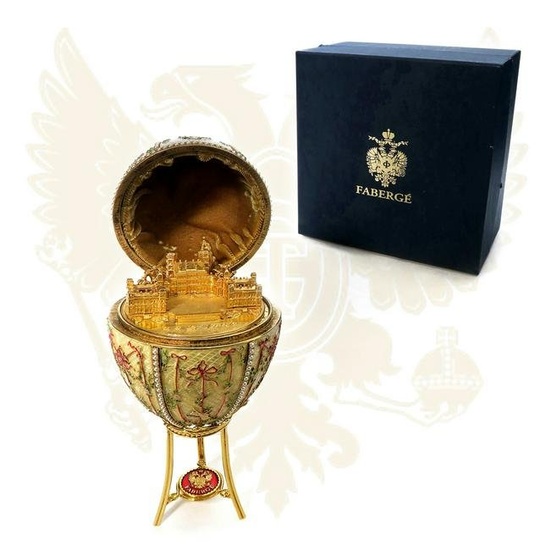House of Faberge Gatchina Palace Egg
Gatchina Palace (Faberge egg): The egg was created by Faberge's workmaster, Mikhail Evlampievich Perkhin (Russian, 1860-1903), and is crafted from gold, enamel, silver-gilt, portrait diamonds, rock crystal, and seed pearls. Detailed work around the palace in the surprise shows cannons, a flag, a statue of Paul I (1754-1801), and elements of the landscape. The miniature palace is fixed inside the egg and cannot be removed, unlike the 1908 Alexander Palace egg, which Faberge would create seven years later for Alexandra Fyodorovna. The dimensions are 4 15/16 x 3 9/16 in. (12.5 x 9.1 cm). In 1920, the egg was in the possession of Alexander Polovtsov, who was a former employee at the Gatchina Palace and later started an antique shop in Paris. It is not known how Mr. Polovtsov acquired the egg. In 1930, this egg was sold, along with the 1907 Rose Trellis egg, to American Henry Walters and became a part of the Walters Art Museum Collection in 1931. In 1936, the egg was exhibited with the Rose Trellis egg at the Walters Art Museum in Baltimore, Maryland, and it has been on permanent display since 1952.
[ translate ]View it on
Estimate
Time, Location
Auction House
Gatchina Palace (Faberge egg): The egg was created by Faberge's workmaster, Mikhail Evlampievich Perkhin (Russian, 1860-1903), and is crafted from gold, enamel, silver-gilt, portrait diamonds, rock crystal, and seed pearls. Detailed work around the palace in the surprise shows cannons, a flag, a statue of Paul I (1754-1801), and elements of the landscape. The miniature palace is fixed inside the egg and cannot be removed, unlike the 1908 Alexander Palace egg, which Faberge would create seven years later for Alexandra Fyodorovna. The dimensions are 4 15/16 x 3 9/16 in. (12.5 x 9.1 cm). In 1920, the egg was in the possession of Alexander Polovtsov, who was a former employee at the Gatchina Palace and later started an antique shop in Paris. It is not known how Mr. Polovtsov acquired the egg. In 1930, this egg was sold, along with the 1907 Rose Trellis egg, to American Henry Walters and became a part of the Walters Art Museum Collection in 1931. In 1936, the egg was exhibited with the Rose Trellis egg at the Walters Art Museum in Baltimore, Maryland, and it has been on permanent display since 1952.
[ translate ]


